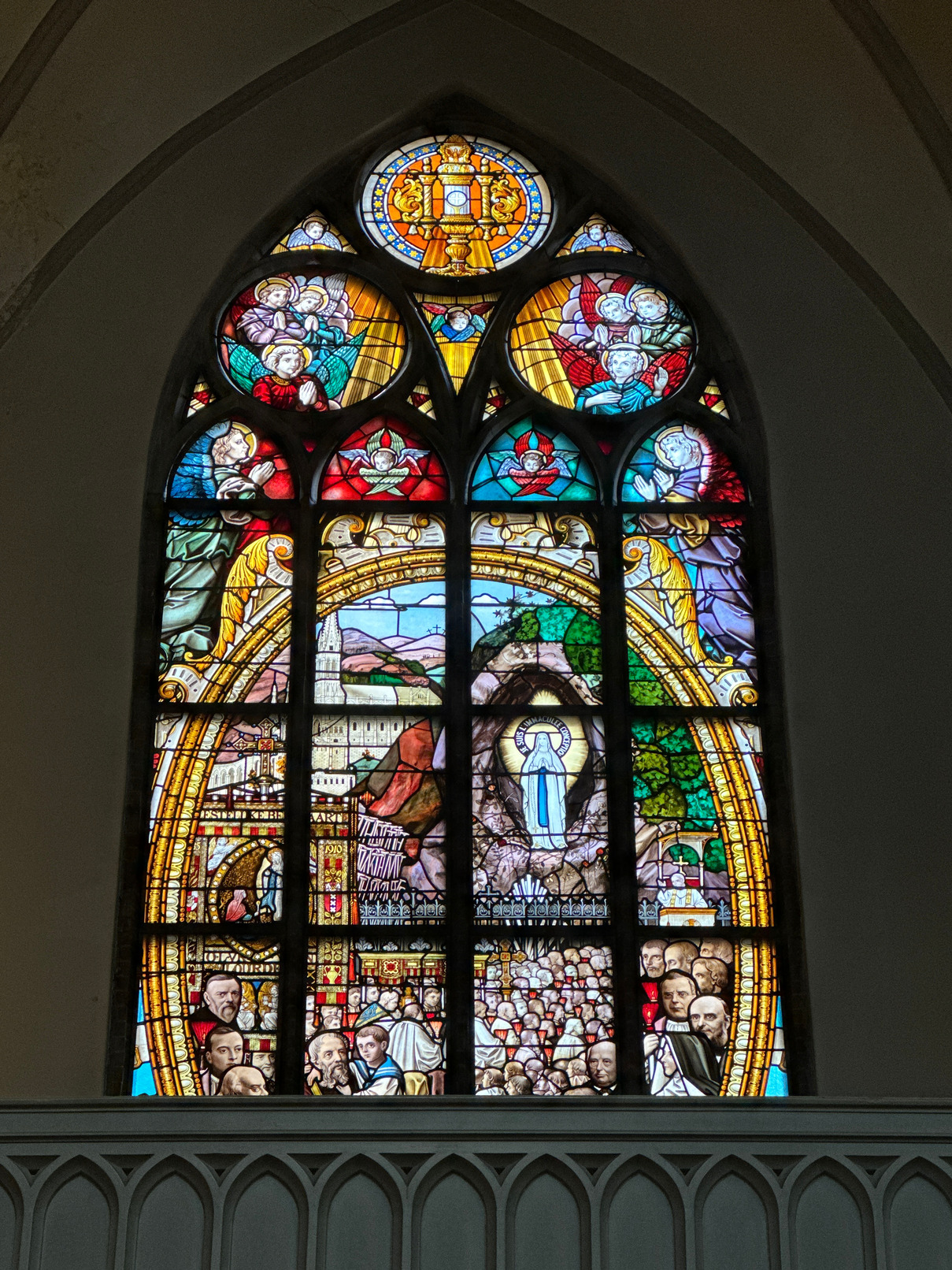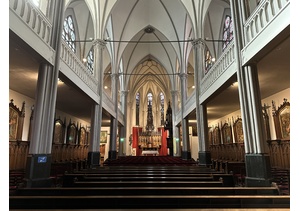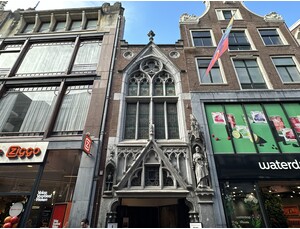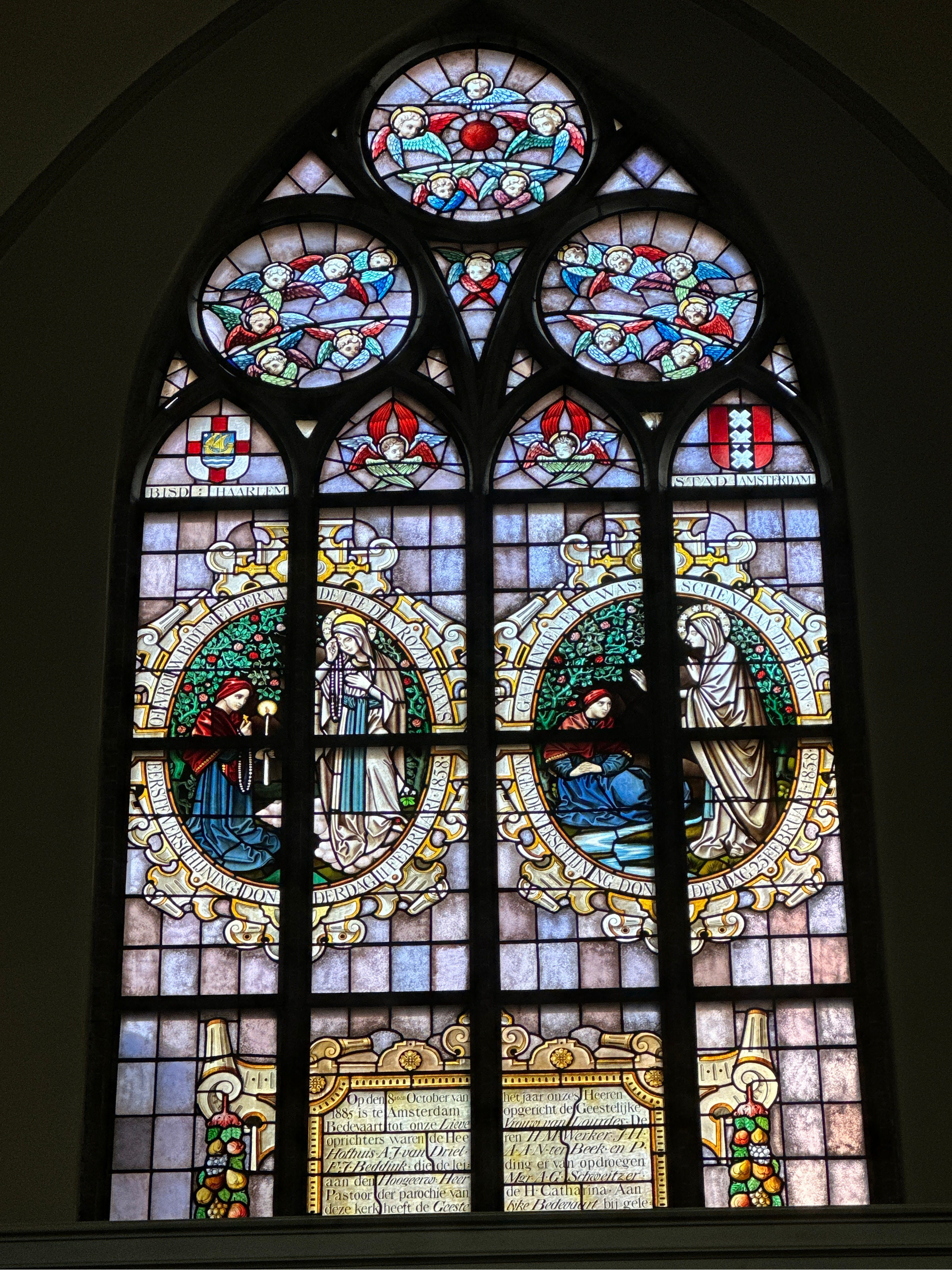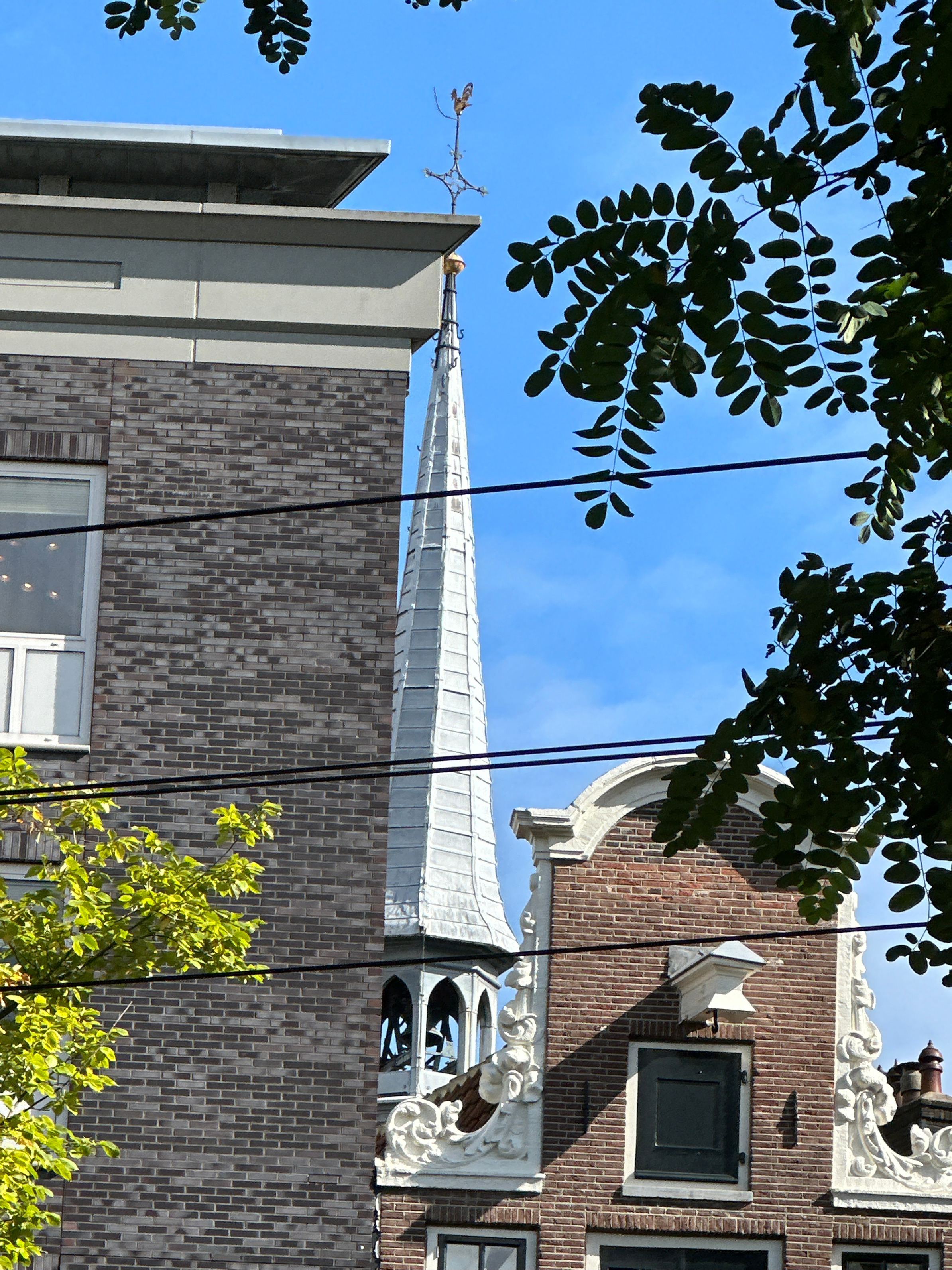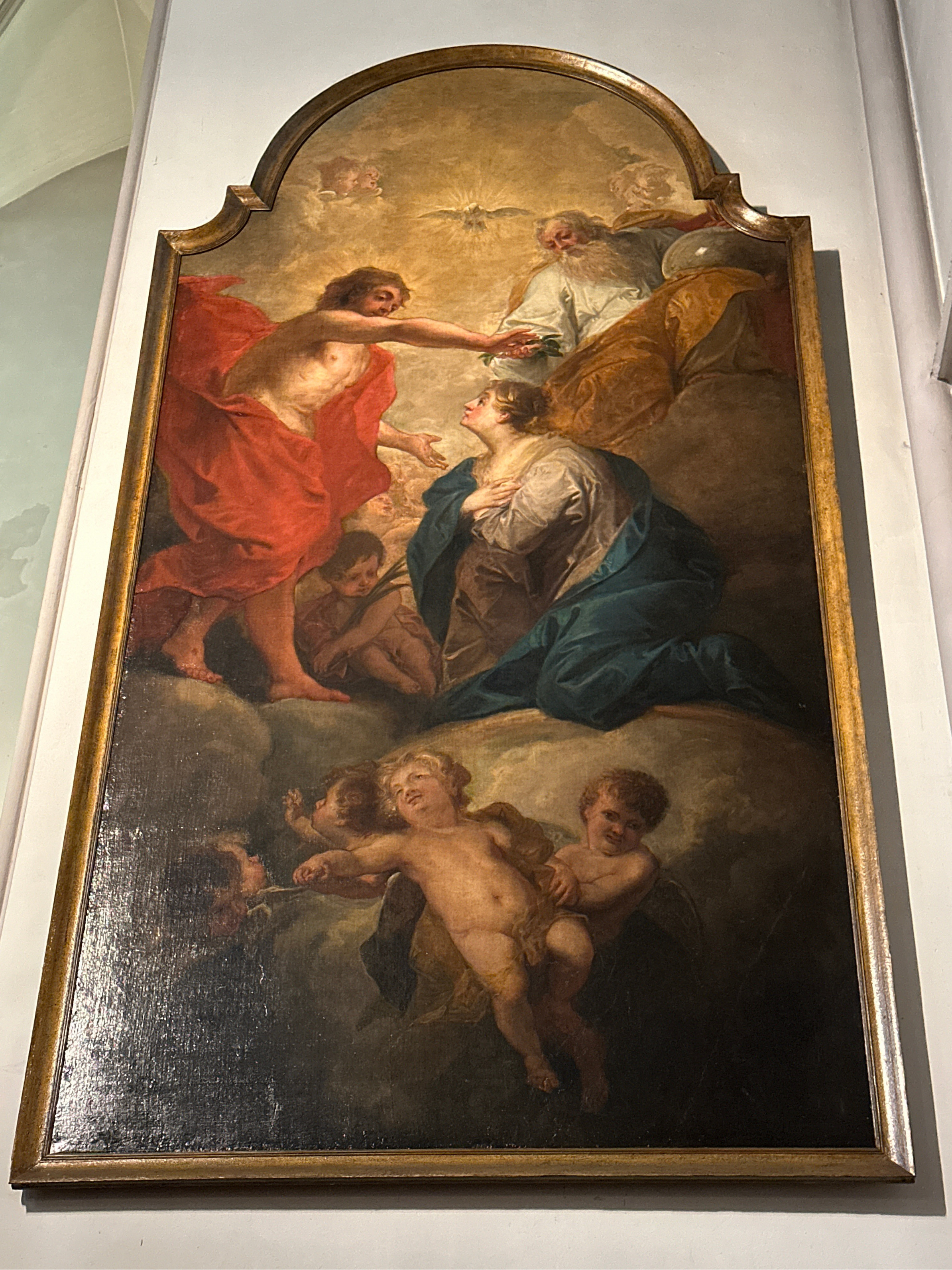The interior of De Papegaai is made up of objects from many different, often vanished, churches. In this way, it tells not only the story of this one church building.
Location
De Papegaai (Saint Joseph Church)
Kalverstraat 58
Type
Church
Religious community
Roman Catholic Church
Object
Window displaying the Mary apparition in Lourdes and portraits of board members of the Foundation for the Spiritual Pilgrimage to Our Lady of Lourdes
Maker and date
Maker unknown
1910
Visit
The windows can be viewed from a distance on the ground floor of the church
De Papegaai (The Parrot), or Church of Saint Joseph, today belongs to the Nicolaas Parish, together with the Basilica of Saint Nicholas. In recent decades, Catholic churches and parishes in Amsterdam have been closed or merged. This is clearly visible in De Papegaai. The church has taken over artworks, statues of saints, and furniture from various dissolved parishes and demolished church buildings.
On the gallery on the north side we see two Lourdes windows. These windows depict the story of the apparition of Mary and the subsequent pilgrimage tradition at Lourdes. They come from the Church of Saint Catherine (the successor of the hidden church the Lily, also called Faith, Hope and Charity) on the Singel. Today, the University Library stands on that site. The church was demolished in 1939. Inside was a Lourdes grotto, with a large Lourdes window above it. After the demolition of the St. Catherine’s Church, the window ended up in De Papegaai, where it was divided across two windows. The Foundation for the Spiritual Pilgrimage to Our Lady of Lourdes also moved along. The foundation still exists today and sells water from the Lourdes spring in order to help people finance a pilgrimage.
hidden church
Building in which hidden religious services were held in the Dutch Republic (1588-1795). Christian denominations outside the Calvinist church, such as Catholics, Lutherans, Mennonites and Remonstrants, had to practice their religions in hidden churches.
Parish
A parish is a community of Christian believers with its own church building; the pastoral care is entrusted to a parish priest (also called pastor).
Lourdes grotto
From February to July 1858, the Blessed Virgin Mary is said to have appeared eighteen times to a fourteen-year-old French girl in a grotto in the Pyrenees, near Lourdes. From around 1875, copies of this Lourdes grotto were built all over the world in honor of Mary. (Brabants Historisch Informatie Centrum)
Next to these, there are also objects present from other disappeared churches. In the baptistery stand two beautiful statues of angels that come from the French Church. This hidden church stood on the Nieuwezijds Voorburgwal and was closed in 1911. In addition to these statues, the Papegaai also temporarily adopted the patron saints Peter and Paul, and from 1912 was officially called the Church of Saints Peter and Paul. In 2021, it was decided to return to the church’s original name: the Church of Saint Joseph.
To see a remnant of yet another church, we must leave De Papegaai on the rectory side, the Nieuwezijds Voorburgwal. From there we can see a small turret. It's cross with rooster come from the Heilige Stede, demolished in 1908.
Heilige Stede
Literally ''holy place''. It refers to the location on Kalverstraat where the Miracle of Amsterdam took place in 1345. After the Protestant takeover in 1578, this church was also called Nieuwezijds Kapel. The original church that stood at this location was demolished in 1908 and was replaced by a new church building also called the Nieuwezijds Kapel.
patron saint
A patron saint is a saint who is regarded as the protector of a particular place, profession, association, or person.
Alongside all these pieces from other churches, De Papegaai also contains art works that have been here for centuries. An altarpiece depicting the Coronation of Mary by the famous eighteenth-century painter Jacob de Wit does belong to the church’s original collection. The Amsterdam historian Jan Wagenaar described all Catholic hidden churches in 1765, and he already mentioned this Coronation of Mary in this church. Therefore, despite all the changes, this work remained a stable part of the church interior.
Liduine Reuser
Last edited
October 08, 2025
Left Lourdes Window, maker unknown, onbekend, 1910, glas-in-lood. Collectie Sint-Nicolaasparochie, Amsterdam.
Interior and exterior: photography Our Lord in the Attic Museum.
Right Lourdes Window, unknown maker, 1910, stained-glass. Collection Sint-Nicolaasparochie, Amsterdam.
Tower of the Heilige Stede, unknown maker, fifteenth century. Collection Sint-Nicolaasparochie, Amsterdam.
Coronation of Mary, Jacob de Wit, 1741, oil on canvas. Collection Sint-Nicolaasparochie, Amsterdam.
Dael, Peter van, De Papegaai (Amsterdam 2007).
Dunk, T.H. von der, 'De bouw van de Papegaai: Amsterdams eerste neogotische katholieke kerk', Jaarboek Amstelodamum 97 (2005) 155-183.
Grijpink, P.M., 'De kerk van den H.Josef te Amsterdam', Bijdragen voor de Geschiedenis van het Bisdom van Haarlem 33 (1911) 271-313.
Hout, Guus van den en Robert Schillemans, Putti en cherubijntjes. Het religieuze werk van Jacob de Wit (Haarlem 1995).
Tepe, Wim, XXIV paepsche vergaderplaetsen (Amstelveen 1984).
Online sources
Website van De Papegaai
Last visited 22-09-2025


